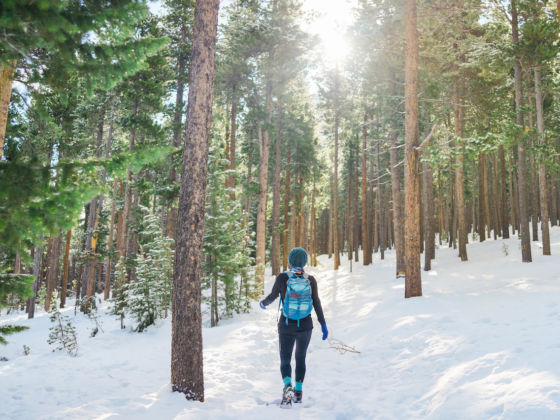A couple winters ago I was snowshoeing with my wife in the Indian Peaks Wilderness in Colorado. It was in the upper 20s with thickening clouds and upslope winds that carried a faint smell of cow manure–the odor whisked off the great stockyards down in the prairie. These are all signs it would be snowing at any moment. Five hours or five minutes, you could never tell.

We set off on a familiar trail up to Lefthand Reservoir. It would just be a short day. Maybe three hours. We had a thermos of hot Earl Grey and some powerbars. One extra layer apiece in our daypacks.
The snow was packed along the trail. We got into a rhythm, noting deer and and elk tracks, rabbits and squirrels. Foxes. You were always on the lookout for bobcat tracks. Or mountain lion. After about 15 minutes a light to medium snow started falling. We cut off trail, where the tree cover helped keep the snow out of our faces.
We meandered through deep powder towards a gulley. This was what we loved about snowshoeing–you could go anywhere that looks interesting. Here was one of my favorite kinds of places, a steep ravine where lichen-bearded firs grew dense along the edges.
We continued traversing along a direction I believed was paralleling the road to Brainard Lake. All we’d have to do was cut downhill whenever we got tired and that road would take us back to the car.
We stopped after an hour. The temperature had dropped and the snow was coming down heavy now.
We had tea, but the powerbars were frozen. I showed Lau how to put it inside her parka so it would thaw out later. We couldn’t stay long with our mittens off.
After traversing a while longer we came to a clearing. There was a lake I’d never seen before. On the other side was a small structure, an old abandoned cabin or hunting lodge.
Out in the open the snow was really coming down. I looked back and realized that our tracks were quickly filling. Our trail in was probably gone. I looked around some more. I couldn’t see the road from here.
Lau sensed my concern and asked me if everything was ok. I told her it was, but that we should begin heading back to the car. I knew that no matter what it was downhill.
We started breaking fresh fresh tracks alongside the creek draining the small lake. This led to another small gulch and wetlands that was thick with alder and willow. It was too hard to follow there so we began climbing a small rise and worked our way around.
On the way around I tried not to dwell possible scenarios. But several passed through my mind.
My main thought was that if we got trapped out in the open we didn’t have enough gear to survive a big storm We could maybe work back up to the cabin but it would only offer minimal protection (the roof and walls were halfway caved-in).
The snow was light and powdery and we didn’t have tools to build a snowcave. Without really thinking about it or meaning to I’d put us in the classic dumbass situation: staking our lives on making it back to a vehicle. And why? Because I knew the terrain. This was just a little hike in our “backyard.”
Only I wasn’t sure now. I still couldn’t see the road. It had to be there though, and after we’d climbed one more small rise, there it was. We hiked down the road, enjoying the hike again, enjoying what had turned into a full snowstorm now. But when we got back to the car we talked about how next time we had to be more careful. We’d gotten off easy.
Invest time in learning winter survival camping and survival skills, such as building a snow cave. Photo by iwona_kellie
Here’s what we decided to have next time we went out, even for a day hike:
- Map and Compass (or GPS). — In this case I knew the terrain intimately, but if I’d had my map on me (instead of sitting in the car) I would’ve seen that small pond and known exactly where I was. And if the visbility had dropped due to heavier snow, we might not have been able to reach the car without a compass or GPS. If you get in white-out conditions, all sense of direction disappears.
- Emergency Shelter — Had we gotten trapped out there, a lightweight shelter such as my megamid, or even just a tarp and a sleeping bag would’ve meant the difference between an uncomfortable but survivable night, and a potentially deadly situation.
- Extra Food — We decided to make always keep at least a couple extra chocolate bars, nuts, and other rich foods in a sealed container. Having a quick and easy supply of calories would’ve made a big difference as well had we been caught out.
- A different attitude — Again, part of our ill-preparedness was due to the fact that this was our “backyard” terrain. I’d backcountry snowboarded this area, hiked and camped it in every season. But what we need reminding sometimes is that familiarity can breed nonchalance, which is never the right attitude to have in the wilderness. It’s all about respect.
With the recent slew of deaths around the backcountry this season, this experience–one that could’ve been a lot worse–has been on my mind lately. Keep it safe out there everyone. Don’t stake your lives on making it back to a vehicle or ski lodge.
You owe it to yourself, your friends, loved ones, and crew: be prepared no matter what.